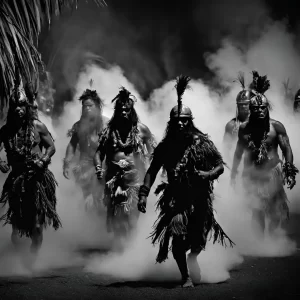The Nightmarchers of Hawaii

Before we screech down the highway of Island nasties and start relating the tale the Nightmarchers of Hawaii, we first need a crash course on Hawaiian religion.
Let’s be honest, our collective middle American understanding of Hawaiian culture and traditions can be summed up in the following string of non-sequiturs: Moana, Lilo and Stich, surf music, tiki-bars, and for the oldies, Elvis with a Uke… given that black hole of understanding, here’s a cheat-sheet on the near Bikini Bottom locality that is the Pacific theater.
Hawaiian religion meshes together the indigenous religious beliefs and practices of Native Hawaiians. It is polytheistic – that’s high speak for more than one god – and animistic – also big talk, this time meaning It is a rich a belief system with many deities and spirits, including spirits are found in non-human beings and objects such as other animals, the surf, and the sky.
The Hawaiian religious melting pot originated among the Tahitians and other Pacific islanders. The crafty seafaring natives landed in those dreamy islands between 500 and 1300 AD.
Today, Hawaiian religious traditions are protected by the American Indian Religious Freedom Act, but during a period of their history Hawaiians were heavily persecuted for their beliefs.
A rapid-fire point to jot down about the whole religious dogpile, traditional Hawaiian religion is unrelated to the whole New Age whammy known as “Huna.”
The main pantheon, mind there are over 500 ghosts, spirits, and minor deities, of Hawaiian polytheistic belief – the big shots – are Kāne, Kū, Lono, and Kanaloa, Laka, Kihawahine, Haumea, Papahānaumoku, and, most famously, Pele.
Also, each family is estimated to have one or more guardian spirits known as ʻaumakua that shield them from harm. A common practice among certain old world religions. And an even more common practice among religions set within the Pacific Ocean and the influencing spirit of Japanese Shinto (lso known as kami-no-michi).
It’s really a highly diverse spiritual pantheon and one that unlike others of its kind is very much active in the modern world. It’s not a close loop system whose laws, doctrines, and dogmas are set, but one that constantly flexing and evolving with the times. Each generation adding their own set of rules, believes, and spices into the telling.
The Nightmarchers Of Hawaii
In Hawaiian myth, Nightmarchers (huaka’i pō or “Spirit Ranks,” ‘oi’o) are the murderous shades, demons, revenants that haunt the island. They are the rabid galvanized specters of ancient Hawaiian fighters, heroes, and warriors.
On key nights worshiping the Hawaiian gods or on the nights of Kanaloa, legend has it that the Nightmarchers spring forth from their burial sites, or to rise up from the sea. They don their battle regalia and march platoons towards classical Hawaiian battles sites or to other holy sites.
Old-timers and myth tellers say the Nightmarchers are normal-size warriors, dressed for battle, bearing lances, maces, and other classical Hawaiian weaponry of old. They are accompanied by a marching band; a detachment of military musicians beating on war drums and blowing tones from conch shells. The wind carries their song and, like the banshee, all who hear the advancing of their march meet a tragic end.
The tale further states that the Nightmarchers float, they are suspended, in the air; their heels do not touch water or ground as they cross into the night. They vanish before dawn and leave no evidence of their visitations… except for the dead and missing that might have crossed their path.
The Nightmarchers travel in darkness right after sunset and march as an assembly of murderous wraiths until just before sunrise. Nothing stops them. Nothing is able to halt their mass. They are an unstoppable horde of Walking Dead creatures with the intelligence and ferocity of the warrior spirit they have within their rotting flesh… in other words, smart, fast, heavily armed, super zombies that fly… just picture that nightmare.
Avoiding the coming death
Anyone living along their route who may hear their chanting, or the notes of blown conch shell’s tones, or even their hooves on the night wind, must be cautious. Mortals must find refuge immediately, lay on the floor, and never look up or towards the racket. They must avoid being noticed by Nightmarchers; otherwise, harm or even death might be their reward.
Nightmarchers only appear during the day to escort a dying family member to the spirit world.
Ancient Hawaiian tenets assert that any mortal gazing upon or being viewed in defiance to the marchers will die horribly and violently.
Some people declare that if the mortal lies still, down on the ground, prostrated to the marchers they are giving proper respect, fear, and reverence to the Nightmarchers; and they will be forgiven and spared.
Also, mortals can circumvent any harm or destruction from Nightmarchers by being lucky enough to have an ancient ancestor that’s a marcher; a soldier within their family tree. If a familiar Nightmarcher – say your granddaddy – encounters a mortal, they’ll call out “Na’u!” – “mine” – in Hawaiian; clamming that soul and telling the procession that it’s their property and not to harm them.
Another way to avoid the Nightmarchers is by planting living ti (Cordyline sp.) ferns around the house. It is a powerful amulet said to keep evil spirits – huaka’i pō – at bay.
The protocol and behavior of the marches are customized to the tastes of its venerated warrior leader; a bit like the European Wild Hunt. Each walk a new warrior from the march’s ranks is honored and in doing so the whole procession adheres to that spirit’s predilections.
A Hawaiian King or Chief that is known to be enamored of music would be honored with drumming and chanting. If the honored meanwhile loved the sound of silence, then the march would walk of cat’s feet through the iland. If the warrior was particularly ruthless, then the march would wreck all kinds of havoc and mayhem… If the warrior valued peace, then the march would spare the mortals it might cross.
In old Hawaiian folklore, the laws held that body parts of a King or Chief or honored dead, were sacred, and could not to be seen by a mortal. The penalty for viewing these parts was always instant death. Bolts of intense light and flaming heat would spark from the phalanx of warriors. The beams incinerating the violating mortal like Superman’s heat vision.
Frequently Hawaiian gods are present during the marches. If a god is present, the Nightmarchers’ torches are said to burn brighter; their fanfare more electric and magical.
Spotting a Nightmarch in Hawaii
- Loud war drums in the distance.
- A smell foul and musky. The odor of death.
- The crying of a conch shell being blown; a fair warning to mortals to get the hell out of Dodge.
- Fire in the distance, as the torches get closer and brighter.
- Animals going silent.
- The wind stopping.
- Obstacles arranged in the way of Nightmarchers will not hinder them. Only the proximity of ti plants can redirect the marchers.
- One Island tip is to never buy a residence with the back door lined up with the front door; makes it easy for the Nightmarchers to come in and prance around your house like it’s a highway.
Night Marcher trails
- Oahu’s Pali Highway.
- The Kamehameha Schools campus in Kapalama on Oahu.
- Kualoa Ranch on Oahu’s windward coast
- La Perouse Bay, an area in the Ahihi-Kinau Natural Area Preserve in South Maui.
- The town of Kaunakakai on Molokai.
- La’ie on Oahu.
- Nu’uanu Pali Lookout.
- Ka’a’awa Valley.
- Kalihi Valley.
Hawaiians are very cautious of the Nighmarchers, the natives afraid by their awesome power. Families constantly honoring their fallen warriors and soldiers and doing their level best to have their spirit on their side just in case calamity hits and they are wrestled into the insanity that is one of these marches.
For more macabre tales check out our blog.
Source:
https://www.to-hawaii.com/legends/night-marchers.php
https://en.wikipedia.org/wiki/Hawaiian_religion
